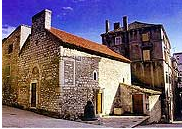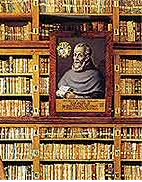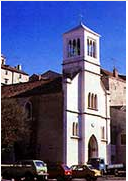In the part called Grad, the following monuments of sacral architecture stand out by its completeness, coherence and stylistic peculiarities.
St. John’s church
It is a gothic renaissance construction dating from the second half of XV ct. Along the south side is a staircase whose lintel was ornamented with a bas-relief by IvanIvan Pribislavić, a local constructor. Renaissance master Nikola Firentinac built the staircase balustrade. Firentinac is also the author of the work done on the south wall of the tower’s ground floor (window above which stands an angel with wide-spread wings and the Lamb of God) as well as of the sculpture of St John.
In 1648 a great stone dial of Šibenik’s first public mechanic clock was built in the upper part of the tower’s west wall.
St. Krševan’s church

Originally it was a Romanic style construction built in XII ct. With its architectural separation in XV ct. the church acquired many gothic characteristics. In the Second World War it was severely damaged. After the restoration it became Museum of the city of Šibenik’s exhibition room and today it is the place of St. Krševan’s Gallery. Next to the church there is the oldest bell in Croatia . It was built in 1266 and found in the sea near island Silba.
St. Lovre’s church and monastery
The church was built in XVII ct. for brethren of Franciscan order. Many craftsmen from Dalmatian sculpture workshops worked on the church (Trifunović from Zadar, Pavlović and Vidović from Korčula and many others). In the sidewall tympan there is a small sculpture of St Lovre from 1720. A cave of Our Lady of Lourdes was decorated in front of the facade, in the southern rock dent. Opposite the church there is a Franciscan monastery from 1650. Its main building is the Foscol’s Palace, the most beautiful example of Šibenik’s XV ct. residential architecture, from the flowery gothic period.
The New church
The new church is a renaissance temple from the turn of XV ct. The façade is decorated with a portal and two columns with Corinthian style capitols. On the church’s east side there is the fraternity’s gothic hall. Between the church and the fraternity hall there is a small yard surrounded by a gothic-renaissance porch. On the wall’s south side is the renaissance relief of Christ’s burial placed there by Nikola Firentinac. Paintings on the ceiling were made by local artists Mondella, Sisanović and Bojković. Upper parts of the wall are decorated with frescoes(paintings) done by Parkić and Moneghin, Šibenik painters from the second half of the XVII ct.
St Grgur’s church
This rather small gothic sacral object is situated in Juraj Dalmatinac street , the oldest street in Šibenik. In this narrowest city passage the Masters home used to stand, opposite St Grgur’s (St Gregory’s) church. After its restoration it served as exhibitions room of Museum of the city of Šibenik which used it to set up a permanent thematic display of Juraj Dalmatinac and his work outside Šibenik. The exhibition demonstrates Juraj’s construction and sculptural opus in Prague , Split , Dubrovnik and Ancon.
St Frane’s monastery and church

It is an architectural complex of Šibenik’s Franciscans situated in outer southeast part of the city centre. The church is a single nave gothic building devoid of decorative architectural elements. It was built in the second part of XIV ct. In XV ct. on the church’s north side a chapel of St. Cross was built and a presbytery with sanctuary renovated. On the front there’s the main entrance with simple gothic stone edge. In 1674 the church was given a wooden cassetted ceiling decorated with the works of Giovanni Battista Volpat’s Venetian baroque workshop.
Along with the three marble altars there are four wooden altars on the church sidewalls. On three of them we see big altar paintings painted by the most famous and most original painter in XVII century Dalmatia – Matej Poncun (Ponzoni). In St. Cross chapel one finds the organ created by Petar Nakić, a notable Croatian organ designer. On the south side, next to the church, is a monastery built in the second half of XIV ct. St. Frane’s (St Francis’) monastery had in important role in the cultural and social life, especially in preserving the Croatian language. It contains a great part of the city’s monumental heritage and an archive fund of major significance in studying the Franciscan order, Croatian aristocrat family of Šubić Bribirski and the city of Šibenik itself.

The monastery library is known for its rare books and a collection of 140 incunabula. An item of unique value is the codex manuscripts’ collection from XI-XV ct. characterized by richness and high artistic quality illumination. In one of those is the “Šibenik pray”, one of the oldest Croatian linguistic and literary Croatian monuments written in Latinic letters, dating from around 1375. Valuable examples of church garments, bowls, artefacts, relics, and painting collections are guarded in the monastery treasury.
St. Nikola’s church
It was built in XVII ct. in baroque style and belonged to the fraternity of Šibenik’s sailors and shipbuilders. The church’s front part ends with the Croatia-typical “preslica”-ending tower, and lower parts are divided by windows and by a portal with unadorned frames. It’s interior is quite plain; On some of the ceiling fields there are characters of saints with portraits and names of donators in popular costumes of the time.
St. Dominic’s church

Up to 1910 it had been a renaissance sacral building with “preslica”-ending tower. After the restoration the church was given pseudo-gothic characteristics. From the renaissance elements only the portal remained. There are two valuable wooden altars inside the church. One of them contains a picture of Madonna with the child and St. Vincent (the end of XVI ct.), and the other the Circumcision of Christ, attributed to Giovanni Laudis (1587-1626), Palma Junior’s disciple. Inside the church there is a tomb of Arrigoni, the bishop of Šibenik (1599-1626) and an organ (musical instrument) crefted by Gaetano Moscatelli, a well-known successor of famous organ designer Petar Nikić.
The church of Uspanie Bogomatere
Large baroque building dating from XVII-XVIII ct.; its facade was probably designed by the famous baroque architect Ivan Skok. Up to XIX ct. it had been a catholic church belonging to the female Benedictine monastery. In 1808 French government abolished the monastery and handed the church of St. Salvation over to Serbian orthodox episcope. Inside the church are many artefacts of significant cultural, historical and artistic value. The most important is Ikinostas (1827) by the famous icons’ artist Aleksije Lazović.
The church of Holy Ghost
It is a church with characteristics of the late renaissance period. It was built in the first decades of XVII ct. following the blueprints of Šibenik citizen Antun Nogolović. Semicircle gable at the facade end has a purely decorative function. Lower part of the façade is divided by a portal and four stone rimmed windows. On the church’s west side there is a staircase with a late gothic balustrade leading to the church choir area.
St Barbara’s church
It is a gothic single nave building from the first half of XV ct. At its front, above the entrance, there is a statue of St. Nikola. It was sculpted by the Italian Bonino da Milano. The façade ends in two baroque “preslica”-ending towers on. On the north wall there is a gothic window, below it a sculpture donated as a votive gift by a Šibenik doctor, surgeon Marko (in 1419). Inside the church is a small church museum which displays the most valuable paintings, sculptures and other important artwork from XIV to XVIII centuries.
